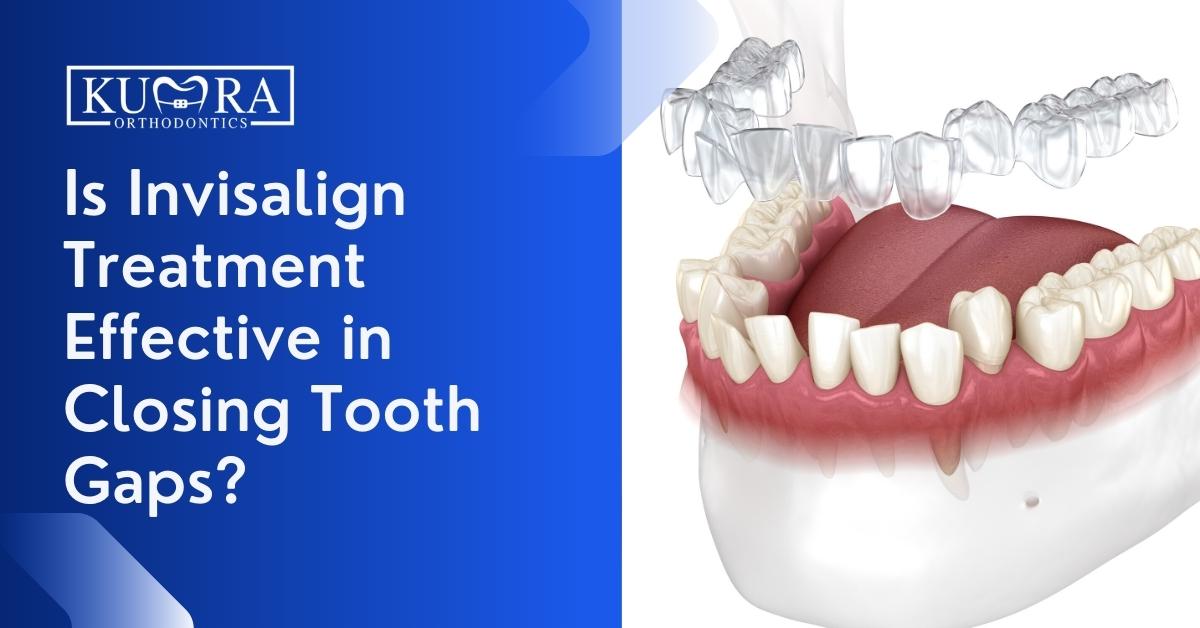Invisalign is a tooth straightening brace system created for teenagers and adults looking for alternative treatments that are more discreet than traditional braces to address orthodontic issues such as crooked teeth, and gapped teeth.
Keep in mind that patients will require the assistance of a specialist in order for any potential dangers or threats that may lie dormant within their mouths to be identified or diagnosed. For instance, patients who are suffering from gum infections or tooth decay will need to have these concerns treated before receiving their treatment.
In this article, we’ll address how Invisalign can help address gapped teeth.
What are Tooth Gaps
Diastemas, more commonly known as tooth gaps, are spaces that exist between each individual tooth. The spaces, which can be very little or rather extensive, might appear for a number of different causes.
The most frequent type of diastema, known as midline diastema, occurs when there is a space between the upper front teeth. However, diastemas can occur in any part of the mouth. In extremely unusual circumstances, patients may even have gaps between the rest of their teeth.
Teeth that are too far apart, often known as gaps between the teeth, can range in severity from minor to severe. The orthodontic problem can progress to additional oral health difficulties if it is not treated, despite the fact that a lot of patients seek braces or Invisalign for gap teeth because they don’t like how spacing appears.
If you don’t close the spaces between your teeth, it will be easier for food to become lodged in those areas, and plaque will have more room to build up, increasing the likelihood of tooth decay and gum disease. It’s possible that certain teeth take the brunt of the chewing pressures, causing the enamel to erode unevenly or excessively on those teeth.
Additionally, when teeth are very spaced out, the alveolar bone isn’t stimulated where the gaps are, which can lead to bone loss and, eventually, tooth loss. This is because the bone isn’t being stimulated where the gaps are.
Needing an orthodontic appointment?
Visit Kumra Orthodontics Washington, DC or Kumra Orthodontics Stafford, VA, and request an appointment with us!
How Invisalign Helps with Tooth Gaps
You will also have the ability to close the gap in your front teeth with the help of Invisalign; however, the way it works is completely different than bonding.
Instead of using a resin to fill in the space between your teeth, Invisalign will try to move your teeth into the proper position so that your smile looks better. This is accomplished with the use of a series of aligners made of clear plastic that are tailored to the shape of your teeth and gradually bring about the desired alignment.
When you take out one set of aligners and put in a new set, the space in front of your front teeth will gradually begin to close, and you’ll have the beautiful smile you’ve always dreamed of having.
Does The Aligner Work on Large Gaps?
The majority of tooth gaps can be closed using Invisalign. On the other hand, wider gaps may take longer to close, at which point patients may be required to wear their aligners for a period of time that can extend up to two years. If the spaces are on the upper teeth, the dentist may apply composite to numerous of the afflicted places so that the teeth will shift in the correct direction once the aligner begins to exert its force.
Before deciding whether or not the clear aligner is the most effective method for addressing the issue, a dental team will most likely take x-rays of the patient’s mouth and conduct an oral exam. This is because each patient’s tooth gap is unique.
Invisalign vs. Braces for Tooth Gaps
Gaps between teeth are one of the numerous conditions that qualified orthodontists are specifically trained to manage, so it’s a good thing that they may be treated with careful intervention. There are various different treatment options available for closing spaces between teeth, including the following: Invisalign, along with metal and ceramic braces, is also an excellent treatment option for this issue. In addition to this, a retainer will be utilized so that gaps do not re-open.
Filling in spaces between the teeth is possible with braces. In point of fact, excellent alternatives for addressing space between the teeth include ceramic and metal braces. When you acquire braces to narrow a gap in your teeth, you will first have a consultation with your orthodontist, who will design a treatment plan tailored specifically to your needs.
Suppose you also have other issues in addition to spacing, such as a severe overbite (deep bite). In that case, we may couple your braces with auxiliaries such as rubber bands or temporary anchorage devices. These may be used in conjunction with your regular braces (TADs). When we close the gap between your upper and lower teeth with braces, the rubber bands on your braces will ensure that your upper and lower teeth will come together properly as well.
To execute asymmetrical tooth motions, often known as shifting teeth in the same arch in various directions, TADs function as a fixed anchor point that can be used to push or pull a tooth or teeth in a certain direction.
When you wear Invisalign to close gaps in your teeth, similar to when you receive braces for spaced-out teeth, we may pair your aligners with Invisalign attachments and/or rubber bands. This is similar to what happens when you get braces to address this issue.
Attachments for Invisalign are tooth-colored buttons that are bonded to your teeth. These attachments provide your aligners with additional leverage, which allows them to accomplish more complex tooth movements. Rubber bands used with Invisalign, much like rubber bands used with braces, work to bring the upper and lower arches into the ideal alignment.
Read more: Do People Sleep With Invisalign On?
Consult with Kumra Orthodontics to learn more about Invisalign on Gapped Teeth
If you are self-conscious about your gapped teeth, there is good news – Invisalign can help. Gapped teeth can be corrected with the use of Invisalign braces, and working with an experienced Invisalign dentist like Dr. Kumra will ensure that your treatment goes smoothly. Contact our office to schedule a consultation and find out more about how Invisalign can improve your smile.



